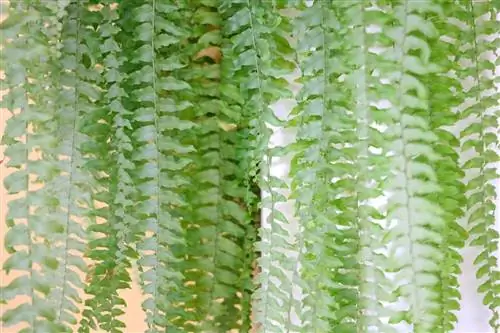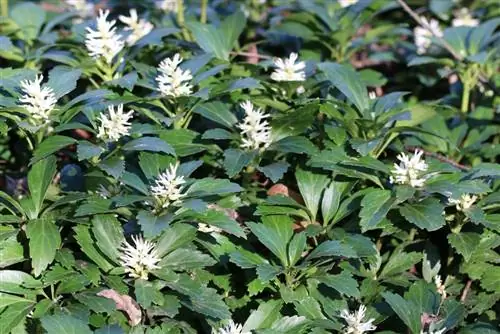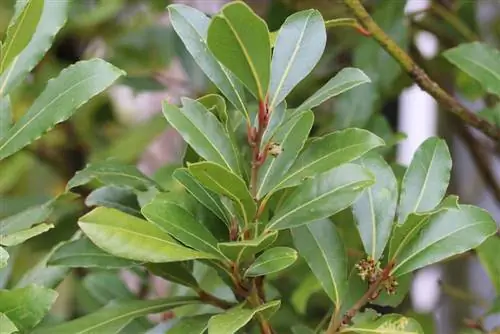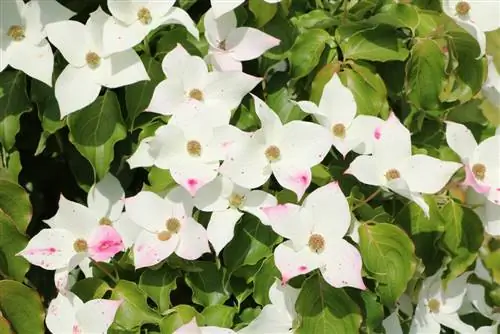- Author admin [email protected].
- Public 2023-12-17 03:39.
- Last modified 2025-01-24 12:45.
Ferns are one of the most popular foliage plants in the garden. They multiply quickly and are not very demanding when it comes to care and location. Despite all this, they differ significantly from other plants in some respects, which justifies a close look at the location, care and propagation.
The plant species
In general, a distinction is made between ferns for the room and the garden. Species that come from warmer regions are traditionally kept indoors in our latitudes because our climate would not allow good growth outdoors.
In return, all ferns that can be found in the garden are completely compatible with our climate and grow and thrive in a wide variety of places. Many different species can be found, especially in garden ponds. The existing biotope is ideal for ferns to grow well. There are around 100 different species that can be kept outdoors, all of which are hardy. These are joined by a large number of ferns that are not hardy and therefore have to be relocated during the cold season.
Tip:
Even though it is so tempting, no fern should be transplanted from the wild into the garden. The soil conditions are usually so different that the fern would not thrive in the garden. It is better to purchase fresh plants from a garden center.
The Location
Most ferns prefer a shady and moist location. They grow in cracks in walls, on ponds, ponds and rivers as well as next to waterfalls, in forests or in ravines. In the garden, the fern is particularly good at the garden pond or in very shady places where other plants might not thrive so well. Due to its very undemanding nature when it comes to location, the fern can be found in almost every garden. It serves as a green border for the garden pond and in this function also offers protection for the fish. Because small predators such as herons or cats can no longer easily help themselves to the fish because of the fern.
Popular locations include:
- on all kinds of water bodies
- on walls
- in forests
- in canyons
- generally in shady and damp places
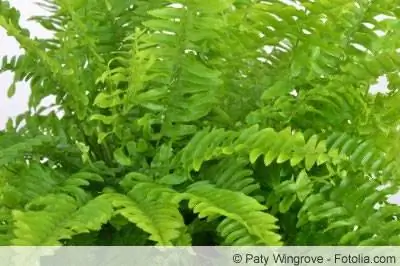
The location should also be chosen depending on the size of the fern. Very large plants should always be presented as individual plants so that they can show their full splendor. Smaller plants only need to be planted far enough apart so that their fronds do not get in the way and can spread fully.
Tip:
If there are free areas on the ground due to planting the ferns far apart, these can be closed with ground cover. For example, pennywort would be very suitable for damp locations.
Care
The soil in which a fern is to be planted should be loosened up a little in advance. Humus and water can be added to the planting hole, which should be deep enough to accommodate the roots after being planted, so that the roots can be immediately supplied with nutrients. You can also work with suitable soil substrates, which can vary depending on the type of fern.
If the farm already has woody or old fronds, these can be cut off before planting. They are of no use to the fern and are therefore just a nuisance. By separating directly at the base of the plant, the formation of new shoots and roots is also promoted.
After planting the fern, the soil around the planting hole can be firmly trampled down. You can also add some bark mulch or peat moss to the ground. Both substrates prevent weeds from forming quickly and the plant is somewhat protected. In addition, the moisture can be better retained in the soil.
The Pouring
Fern likes it to be quite moist in most cases. Constant watering is therefore essential. Particularly in the warm summer months, watering should be done in the morning or evening so that the water does not evaporate too quickly and the fern benefits from it.
Fertilizing
In spring and autumn, the fern enjoys bark mulch that is applied around the plant. In addition, some bone meal can be placed around the plant as a long-term fertilizer. There is no need to dig under the ground as the plants take care of themselves. Dead fronds should be removed regularly so as not to rob the plant of its strength.
Diseases and Parasites

Even though ferns are very easy to care for, they can be affected by diseases and parasites. For example, if a fern falls over, rootworm caterpillars could be responsible. They eat into the roots and damage the fern from below. Slugs nibble on the fronds and cause them to curl up. Borers could also be responsible for this. In many cases, nematodes are responsible for the acute death of the fronds. And small aphids make the leaves sticky.
Tip:
Removing the affected areas in a timely manner ensures that the diseases and pests do not spread to other parts of the plant.
The Multiplication
As a rule, the fern is best propagated by division. To do this, divide the root ball with your hand. This should not only be done very carefully, but also always in spring, before the plant wakes up from hibernation and sprouts again.
But propagation would also be possible via the spores of the ferns. However, the effort is quite large and is therefore only worthwhile for rare plants. In order for this to succeed, the fronds covered with spores must be cut and placed between thin tissue paper. They are then stored in a dry place until the brown spores fall from the leaves and can be read from the paper. The spores obtained in this way can be sown immediately and do not have to be dried first. However, the seeds are not sown in the garden, but in a sterile cultivation container. The plants grow in this for two to three months and are only then transplanted outdoors.
Frequently asked questions
Why is the fern recommended for the garden?
It is very easy to care for and requires little attention. It also grows very well and can provide a good privacy screen at a certain size.
Is the fern hardy?
Around 100 different species of ferns are known in our latitudes, which are hardy and can be found in most gardens.
How can the fern be propagated?
Propagation can be carried out vegetatively - i.e. by division - or generatively - i.e. by sowing the spores.
How do I divide a fern?
In the best case scenario, the roots are divided with your hands. Only very intertwined root sections should be cut apart.


